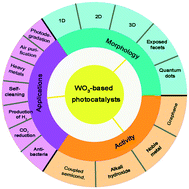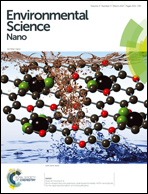WO3-based photocatalysts: morphology control, activity enhancement and multifunctional applications
Abstract
WO3, a visible-light responsive photocatalyst, absorbs light up to 480 nm with several intriguing advantages such as low cost, harmlessness, and stability in acidic and oxidative conditions. In this review, the relationship between the morphology control and the photocatalytic activity of WO3 is analyzed in detail. In particular, the WO3 exposed {002}-dominant facet with high-surface-energy generally shows excellent photocatalytic performance, and the quantum-confined WO3 nanoparticles exhibit a promising future. Furthermore, some main strategies for improving the photocatalytic activity of WO3, such as surface hybridization with graphene, noble metal deposition, semiconductor coupling, and alkali hydroxide loading, are systematically summarized and highlighted. In the noble metal/WO3 composite, the noble metal always works as an electron pool and catalyzes O2 reduction through a multi-electron reduction process to form H2O2 and H2O instead of the traditional single-electron process. In addition, the preparation methods, photocatalytic enhancement factors and possible photocatalytic mechanisms for the WO3/semiconductor composites are described. Moreover, various photocatalytic applications of WO3-based photocatalysts, such as photodegradation of organics, air purification, self-cleaning, CO2 photoreduction, heavy metal ion treatment, hydrogen evolution from splitting water, and bacterial disinfection, are introduced and summarized. Finally, the main conclusions and future perspectives of WO3-based photocatalysts are pointed out. It is anticipated that this review could offer guidelines for designing novel WO3-based photocatalysts with low cost and high efficiency, which can possess promising prospects of application to meet the urgent demands of highly efficient solar energy conversion in the areas of renewable energy and environmental purification.

- This article is part of the themed collection: Environmental Science: Nano 2017 Most Downloaded Articles


 Please wait while we load your content...
Please wait while we load your content...